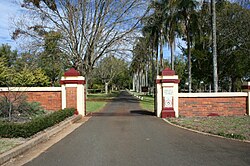| Drayton and Toowoomba Cemetery | |
|---|---|
 Entrance, Drayton and Toowoomba Cemetery, 2009 | |
| Location | cnr South Street and Anzac Avenue, Harristown, Queensland, Australia |
| Coordinates | 27°34′36″S 151°55′10″E / 27.5766°S 151.9195°E |
| Design period | 1840s–1860s (mid-19th century) |
| Built | 1850s onwards |
| Official name | Drayton and Toowoomba Cemetery |
| Type | state heritage (built, archaeological, landscape) |
| Designated | 14 August 2009 |
| Reference no. | 602718 |
| Significant period | 1850 onwards |
| Significant components | memorial – garden, driveway, ground depression, sarcophagus, gate – entrance, memorial/monument, burial/grave, grave surrounds/railings, pathway/walkway, vista/s, headstone, trees/plantings, garden/grounds, shed – shelter, denominational divisions, objects (movable) – burial ground (funerary), trees of social, historic or special significance, tree groups – avenue of, mausoleum/tomb/funeral vault/ossario |
Drayton and Toowoomba Cemetery is a heritage-listed cemetery at the corner of South Street and Anzac Avenue, Harristown, Queensland, Australia. It was surveyed in May 1850, and is one of the earliest surviving cemeteries in Queensland. The cemetery is large, containing over 45,000 burials. It has been run by the City of Toowoomba, and its successor the Toowoomba Regional Council, since 1974; previously it was run by government-appointed trustees. Many prominent people associated with the Darling Downs are buried in the cemetery, and all sections of the cemetery remain in use. Notable Toowoomba stonemasons R. C. Ziegler & Son, Henry Bailey, Walter Bruce, John H. Wagner and the Bruce Brothers are all associated with monuments within the cemetery.
The cemetery was originally divided into denominational sections, with sections for Roman Catholics, Anglicans, Wesleyans, Congregationalists, Jews and Pagans; the latter two were converted into a cemetery for ex-military personnel around the 1950s, and sections for paupers, stillborn babies and Muslims have also been added. The cemetery reserve was extended between 1870 and 1873, with significant improvements being made to the site in the 1870s as Toowoomba developed as a regional centre. Smaller expansions to the cemetery reserve were made in 1882 and 1906. Three shelter-sheds were built (c. 1930), which survive and are part of the cemetery's heritage listing. The cemetery was again expanded in 1957 following concerns that the existing reserve would soon be fully occupied, but little of this has been utilised.
The cemetery was neglected during the 1960s, and by the 1970s many of the graves were overgrown, or had deteriorated or been vandalised. Administration of the cemetery passed to the City of Toowoomba in 1974, with the council restoring the site. A further reserve was transferred to the Council for cemetery purposes in 1987, but has not been used. It was added to the Queensland Heritage Register on 14 August 2009; the heritage listing does not include the 1957 and 1987 reserve expansions.[1]
- ^ "Drayton and Toowoomba Cemetery (entry 602718)". Queensland Heritage Register. Queensland Heritage Council. Retrieved 1 August 2014.

